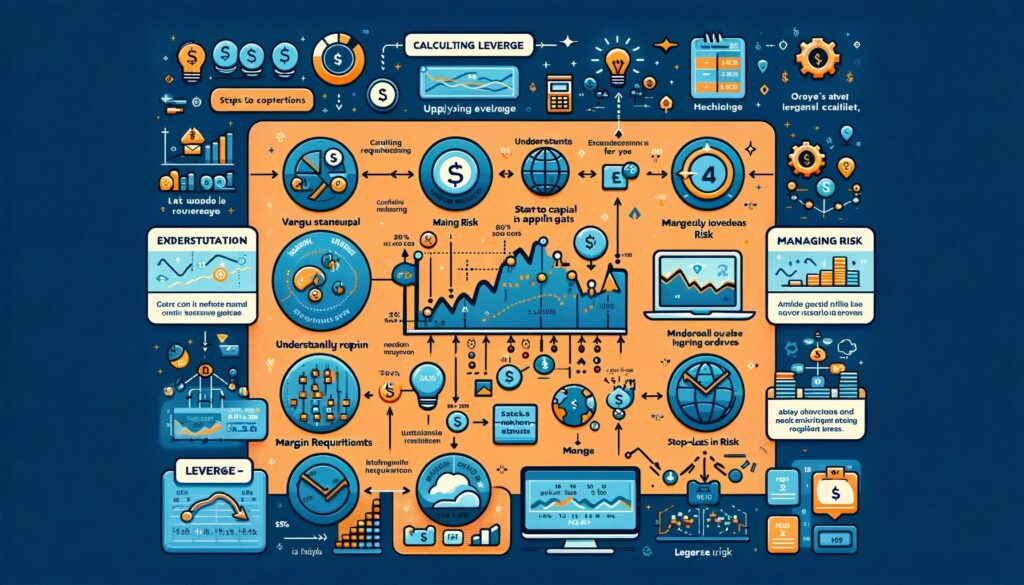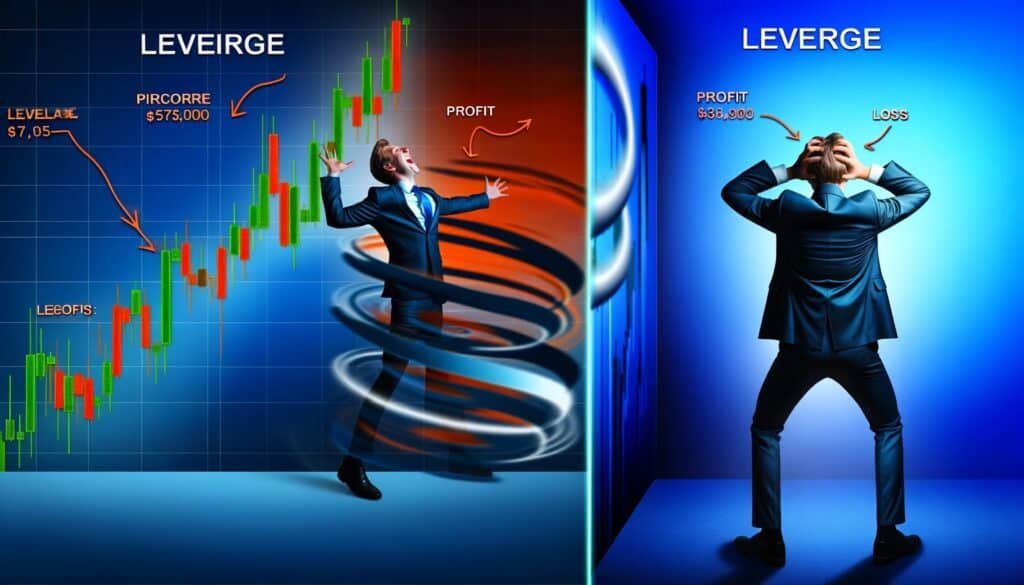Leverage is a pivotal concept in Forex trading, acting as a double-edged sword that can amplify profits as well as losses. This comprehensive guide aims to demystify understanding leverage in Forex, exploring its mechanisms, benefits, and inherent risks, while providing actionable strategies and examples to navigate the leverage landscape effectively.
What is Leverage in Forex Trading?
Exploring the Fundamentals of Leverage in Forex Trading
Leverage in Forex trading allows traders to control a large position with a relatively small amount of capital. It’s akin to using a lever to lift a heavy object, hence the term ‘leverage’. This financial tool increases a trader’s buying power in the market.
Mechanics Behind Leverage
When you employ leverage, you essentially borrow money from your broker to increase your trade size. For instance, with a 100:1 leverage ratio, you can control a $100,000 position with just $1,000 of your own capital. This ratio illustrates the power of leverage, enabling significant market exposure from minimal investment.

Benefits of Using Leverage
Amplifying Profit Potential
Leverage’s primary allure is its ability to magnify profits. A small price change can lead to substantial returns, turning minimal market movements into significant profit opportunities. For example, a 1% increase in a leveraged $100,000 position can result in a $1,000 profit from just a $1,000 investment.
Capital Efficiency and Diversification
Leverage enables traders to spread their capital across multiple trades or asset classes, enhancing the potential for diversification and risk management. This strategic allocation can optimize returns while minimizing exposure to any single currency pair or market event.
Risks Associated with Leverage in Forex Trading
The Double-Edged Sword of Leverage
While leverage can amplify profits, it equally amplifies risks. A minor adverse market movement can lead to disproportionately large losses, potentially exceeding the initial investment, emphasizing the critical need for risk management in leveraged trading.
Margin Calls and Liquidation
A margin call is a risk traders face when using leverage. If the market moves against your position and your account equity falls below the margin requirement, your broker may issue a margin call, requiring you to deposit additional funds or close your positions at a loss. This mechanism underscores the high stakes of leveraged Forex trading.

Best Practices for Managing Leverage Risks
Effective Risk Management Strategies
Adopting a conservative approach to leverage and applying strict risk management tactics are paramount. This includes setting stop-loss orders to limit potential losses, regularly monitoring open positions, and never investing more than you can afford to lose.
Leverage and Trading Psychology
The psychological aspect of trading with leverage cannot be overstated. The potential for large gains can often overshadow the risk of significant losses, leading to overconfidence and reckless trading decisions. Maintaining discipline and a level-headed approach is essential for success.
The Role of Leverage in a Trading Strategy
Incorporating Leverage Wisely
Leverage should complement, not define, your trading strategy. Whether you’re a day trader looking for quick profits or a long-term investor seeking gradual appreciation, leverage can be tailored to suit your goals, risk tolerance, and market outlook.
Examples of Leverage in Action
Consider a trader using 50:1 leverage to enter a position in EUR/USD. With a $2,000 investment, they control a $100,000 position. A 0.5% increase in the EUR/USD pair could result in a $500 profit, showcasing leverage’s potential when used judiciously.

Regulatory Perspectives on Leverage
Understanding Leverage Limits
Various jurisdictions have imposed limits on leverage to protect retail traders from the risks of high leverage. For instance, in the European Union, leverage is capped at 30:1 for major currency pairs to curb excessive risk-taking and protect traders from volatile market conditions.
Navigating Regulatory Environments
Traders must stay informed about the leverage limits and regulations in their jurisdiction, as these can significantly impact trading strategies and potential returns. Understanding these rules is crucial for compliance and effective risk management.
Leveraged Trading: A Balanced Approach
Assessing Your Risk Tolerance
Before employing leverage, assess your risk tolerance and trading objectives. Consider your financial situation, trading experience, and the level of market volatility when determining the appropriate level of leverage for your trades.
Success Stories and Cautionary Tales
The trading world is filled with stories of significant gains and devastating losses stemming from leveraged trading. Analyzing these cases provides valuable lessons on the importance of caution, strategy, and respect for market forces when using leverage.

Conclusion on Leverage in Forex trading
Understanding leverage in Forex trading is indispensable for traders aiming to navigate the complexities of the currency market successfully. While leverage offers the enticing prospect of amplified profits, it also introduces substantial risks that require careful management. By employing prudent strategies, maintaining discipline, and respecting market dynamics, traders can harness the power of leverage to achieve their trading objectives while safeguarding their capital.

FAQs on Leverage in Forex trading
What exactly is leverage in Forex trading?
Leverage in Forex trading is a tool that allows traders to control a large position with a relatively small amount of actual capital. It’s like a financial lever that amplifies the buying power of your investment, enabling you to open larger trades than your existing capital would normally permit.
How can leverage both increase profits and losses?
Leverage works by magnifying the outcomes of your trades. If the market moves in your favor, you stand to make a significantly larger profit on your leveraged position than you would with your initial investment alone. Conversely, if the market moves against you, your losses are equally amplified, which can quickly deplete your trading capital.
What is a margin call in Forex trading?
A margin call occurs when your account balance falls below the broker’s required minimum margin, indicating that your open positions are at risk. To maintain these positions, you’ll either need to deposit additional funds into your account or close some of your trades to reduce the margin requirement.
How can I manage risk when trading with leverage?
Effective risk management strategies include setting stop-loss orders to limit potential losses, closely monitoring your positions, using leverage ratios that align with your risk tolerance, and diversifying your trades. It’s also crucial to have a clear trading plan and not to overcommit your capital to any single trade.
Are there regulatory limits on leverage?
Yes, many regulatory bodies around the world have set limits on the maximum leverage that brokers can offer to retail traders to help protect them from the risks associated with high leverage. These limits vary by country and sometimes by the type of financial instruments being traded.
Can beginners use leverage in Forex trading?
While beginners can use leverage, it’s important for them to understand the risks involved thoroughly. Starting with lower leverage ratios or practicing on a demo account can help beginners get accustomed to the dynamics of leveraged trading without exposing themselves to significant risks.
How do I choose the right level of leverage for my trades?
Choosing the right level of leverage involves assessing your risk tolerance, trading experience, and the specific market conditions. It’s often recommended to start with lower leverage while you refine your trading strategy and increase it cautiously as you gain more confidence and experience.
What happens if I fail to meet a margin call?
If you fail to meet a margin call by either depositing additional funds or closing positions, your broker may automatically close your positions at a loss to prevent further losses that could put your account into a negative balance. This action is taken to protect both the trader and the broker from potentially unrecoverable losses.





